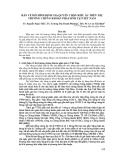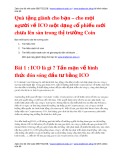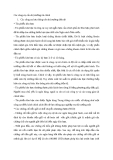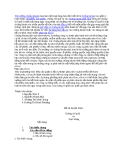
http://www.iaeme.com/IJM/index.asp 382 editor@iaeme.com
International Journal of Management (IJM)
Volume 7, Issue 7, November–December 2016, pp.382–386, Article ID: IJM_07_07_042
Available online at
http://www.iaeme.com/ijm/issues.asp?JType=IJM&VType=7&IType=7
Journal Impact Factor (2016): 8.1920 (Calculated by GISI) www.jifactor.com
ISSN Print: 0976-6502 and ISSN Online: 0976-6510
© IAEME Publication
RUPEE DENOMINATED BONDS (MASALA BONDS)
Syamala Devi Challa
Research Scholar, Department of Commerce & Business Administration,
Acharya Nagarjuna University, Andhra Pradesh, India
Dr. A. Kanakadurga
Assistant Professor, Department of Commerce & Business Administration,
Acharya Nagarjuna University, Andhra Pradesh, India
ABSTRACT
Rupee denominated bonds (RDBs) or Masala bonds are becoming more enticing for both
investors and issuers, and with these bonds, India also stands at a profitable position. Normally
Indian corporate issues debt instruments to raise money from the Indian investors. Unlike debt
instruments, masala bonds are innovative type of bonds, which are linked to rupee but issued to
overseas investors. Masala bond is an effort to protect issuers from currency risk and instead
transfer the risk of currency to investors buying these bonds. The Reserve Bank of India (RBI)
issued a circular authorizing the issuance of masala bonds overseas on September 29, 2015.
International Finance Corporation (IFC), a private sector investment arm of the world bank
named, issued and listed masala bonds, on London Stock Exchange (LSE) in need of infrastructure
projects in India. Mortgage lender Housing Development Finance Corporation (HDFC) was the
first Indian company who raised Rs 5000 crore by issuing masala bonds. This article gives an
overview about masala bonds as how it can be issued, its uniqueness, merits, demerits and its
future.
Key words: Rupee denominated bond, External Commercial Borrowing, Overseas investment
Cite this Article: Syamala Devi Challa and Dr. A. Kanakadurga, Rupee Denominated Bonds
(Masala Bonds). International Journal of Management, 7(7), 2016, pp. 382–386.
http://www.iaeme.com/IJM/issues.asp?JType=IJM&VType=7&IType=7
1. HISTORY AND EVOLUTION OF MASALA BONDS
Masala bonds are creating hype in Indian as well as foreign markets. The recent success of HDFC has
geared so many organizations such as YES bank and the Railways, had also announced their entry into the
overseas market. Before these rupee denominated bonds, the main source for the corporate to raise money
from the foreign market was external commercial borrowings or ECBs. External commercial borrowings
(ECBs) are commercial loans in the form of buyers’ credit, suppliers’ credit, bank loans and securitized
instruments like fixed rate bonds, floating rate notes and preference shares which are non-convertible,
optionally convertible or partially convertible, issued to the non-resident lenders with a minimum average
maturity of 3 years. ECBs can be accessed under automatic and approval routes. Automatic route covers
the borrowings for industrial sector, real estate, infrastructure and some special service sectors. Approval

Rupee Denominated Bonds (Masala Bonds)
http://www.iaeme.com/IJM/index.asp 383 editor@iaeme.com
route covers borrowings for the financial sector. ECBs are dollar denominated bonds which are issued and
repaid in US Dollars. The main threat allied with ECBs is currency risk – if the domestic currency
depreciates, the liability can significantly increase. In ECBs the majority of the risk has borne by the
issuers. While in a rupee denominated bond, an Indian entity issues a bond in foreign markets and the
principal reimbursement and interest payments are articulated in rupees. Masala bonds are issued in rupee
terms and at the maturity time it will be paid in dollar terms leaving the risk of currency to the investors.
In November 2014 International Finance Corporation (IFC) issued the first masala bond in London in
order to increase the foreign investment in India. IFC is the largest global development institution,
established in 1956, owned by 184 member countries. It is mainly focused on financial companies and
private sector companies in developing countries. IFC raised 10 billion Indian rupee bonds ($163 million)
with 10 years of maturity (Nov 2014) to sustain infrastructure developments in India. Masala bonds were
the first rupee denominated bonds listed on the London Stock Exchange (LSE). IFC named masala bonds
as ‘Masala’ to reflect the spiciness and culture of India. The idea was similar to Chinese Dim-Sum Bonds,
which are Yaun-denominated bonds and named after a popular dish in Hong Kong. Another one is
Japanese Samurai bond, which is Yen-denominated bond and named after its country’s warrior. Like any
other off-shore bonds, masala bonds are meant for those overseas investors who want to take experience to
the Indian assets from their locations. But they have been attached to the currency risk or exchange rate
risks since the settlement will be in US dollars. This is because of the limited convertibility of rupee than
the US dollars.
2. RBI’S GUIDELINES ON RDB’S
According to the guidelines issued by Reserve Bank of India (RBI) in September 2015 and modified policy
in August 2016, the money borrowed under masala bonds can only be used for infrastructure funding
purposes. In order to achieve the capital needs and to accumulate fund for the infrastructure projects, RBI
allowed banks to issue masala bonds or RDBs in August 2016. The overall guidelines underlying for rupee
denominated bonds will be similar to that for External Commercial Borrowings (ECBs)
1
.
2.1. Issuers of RDBs
Any corporate body or corporate (an entity registered under Companies Act as a company) formed with a
specific Parliament Act is eligible to issue Masala bonds overseas. According to the September 2015
regulation Infrastructure Investment Trusts (InvITs), Real Estate Investment Trusts (REITs) coming under
SEBIs jurisdiction are also eligible. From the recent August 2016 regulation, banks are also permitted to
borrow such bonds in order to finance their tier 1, tier 2 and infrastructure funding.
2.2. Corporate Issuers and Maturity Period
Indian corporate who is entitled to raise External Commercial Borrowings (ECBs) is also allowed to issue
off-shore Rupee denominated bonds. The RDBs borrowing procedure pursues the same guidelines as the
corporate follows to issue ECBs. The corporate need RBI permission to avail masala bonds if they issue
ECBs under approval route, whereas under automatic route of ECBs issue, RBI approval is not needed.
The payments of coupon and redemptions are settled in foreign currency. The amount to be issued, the
average maturity period (minimum of 3 years) and end use protection (the reason for which these masala
bonds are issued) also consider as per the guidelines under External Commercial Borrowings (ECB)
1
.
2.3. Interest Payments and Maximum Amount
The payments of interest (coupon payment) should not be more than 500 basis points that means under
consequent maturity it shouldn’t be above the superior yield of the Indian Government’s security. For
instance, if the interest rate of a G Sec five-year bond is 6%, then the rate of interest for rupee denominated
bond should not be above 11%. For the conversion of USD-INR, the reference rate of the Reserve Bank on
that date of issue will be pertinent. An eligible issuer can raise a maximum of INR 50 billion or its

Syamala Devi Challa and Dr. A. Kanakadurga
http://www.iaeme.com/IJM/index.asp 384 editor@iaeme.com
equivalent through RDBs under automatic route during a financial year. This limit may be more than the
permitted amount under automatic route of ECB. The fund collected from rupee denominated bonds must
not be used for some restricted areas of FDI and for real estate activities (except for the development of
housing projects and townships).
Table 1 Recent Masala Bond issuers in London Stock Exchange (As on October 2016)
Source: London Stock Exchange
3. INTERPRETATION
3.1. International Finance Corporation (IFC)
• IFC is one of the world’s prime investors for developing countries, mainly investing about $11 billion over
the last decade in long-term financing for climate-smart projects like energy efficiency, green buildings,
sustainable agriculture, private sector adaptation to climate change and renewable power.
• IFC issued INR 2bn in 15 year masala bond in March, 2016 marking as a historic longest-dated overseas
bond.
• The proceeds of the bonds will be used to progress private sector development in India.
3.2. National Thermal Power Corporation (NTPC)
• NTPC is India’s biggest power utility company and its head quarters are located in New Delhi. NTPC was
established by Government of India in 1975 and it was awarded Maharatna status in May 2010.
• The company’s core business entails producing and selling electricity to State Electricity Boards and state-
owned power distribution companies in India.
• NTPC initiated a green bond
2
structure which has been certified by Climate Bonds, an associate of London
Stock Exchange independently.
• The proceeds of the bond will be invested to support solar and wind projects supplementing Indian
Government goal to produce 175 GW of renewable energy by 2022.
3.3. Housing Development Finance Corporation (HDFC)
• HDFC founded in 1977, is a foremost provider of Housing Finance and it is established as the first
specialized Mortgage Company in India.
Issuers of Rupee denominated bond in
London Stock Exchange (LSE)
Transaction Details Issuer
profile
Issue Date Issue Size Coupo
3
Maturity Rating
International Finance Corporation (IFC) 21 Mar 2016
10 Aug 2015
18 Nov 2014
INR 2bn
INR 3.15bn
INR 10bn
7.1%
6.45%
6.3%
15 year
5 year
10 year
AAA/Aaa
National Thermal Power Corporation
(NTPC)
10 Aug 2016 INR 20 bn 7.375% 5 year BBB-
(emr)*
Housing Development Finance Corporation
(HDFC)
12 Oct 2016
21 July 2016
INR 20 bn
INR 30 bn
7.25%
7.875%
40 months
37 months
AAA/
A1+**
British Columbia 09 Sep 2016 INR 5bn 6.6% 40 months AAA/Aaa
European Bank for Reconstruction and
Development (EBRD)
4 Mar 2016 INR 5 bn 6.4% 3 year AAA/Aaa

Rupee Denominated Bonds (Masala Bonds)
http://www.iaeme.com/IJM/index.asp 385 editor@iaeme.com
• HDFC stand for the world’s first Indian corporate issued Masala bond.
• The corporation has raised a total amount of Rs 5,000 crore through the issue of Rupee denominated bonds
(as on October 14, 2016).
3.4. British Columbia
• British Columbia, a Canadian Province was the first foreign government unit to issue a rupee denominated
bond.
• The income from the bond will be utilized by HDFC (one of India’s leading financial services and banking
companies) in India’s housing industry.
3.5. European Bank for Reconstruction and Development (EBRD)
• EBRD was founded in 1991, is a multilateral international financial institution which uses investments as a
device to build market economies. It is owned by two governmental institutions (EU and EIB) and 65
countries.
• The European Bank for Reconstruction and Development has been an important issuer of Indian Masala
bonds in London.
4. MERITS OF MASALA BONDS
4.1. To Corporate
• It helps the Indian corporate to diversify their bond portfolio. While the bond issue is in off-shore market, it
facilitates Indian companies to valve a large number of investor base.
• As interest rates in developed countries are much lower compared to India, Corporate can borrow from
overseas market at low interest rates.
• Being an issuer, Indian entity do not have to bear the risk of currency. That means there is any fluctuation in
the currencies, the risk is totally lies with the off-shore investor.
4.2. To Investors
• An investor in overseas can earn better returns through masala bonds compared to the investment returns
from his home country (In US the bond yield
3
is only just 3% whereas in masala bond it ranges from 5% to
8%).
• An investor benefits from the masala bond if the rupee appreciates at the time of maturity.
• Rupee denominated bonds are building interest in the investors who are even unwilling to invest in the off-
shore market.
• In order to attract and benefit more foreign investors, the Ministry of Finance has cut the withholding tax (a
deducted tax at source on populace outside the country) on interest proceeds of bonds from 20% to 5%. And
capital gains from appreciation of rupee are also exempted from tax.
4.3. To India
• As India has ambitious with few many goals like digital India, developing smart cities, Make in India etc, it
will need around INR 26 lakh crore in next five years. Rupee denominated masala bond is an efficient way
to tap foreign capital.
• Masala bonds help in rising up the off-shore investor’s confidence and knowledge about Indian economy.
• In India many long term projects like infrastructure and power are hindered due to shortage of capital. Long-
term Rupee denominated bond is the best solution for road, power and infrastructure companies.

Syamala Devi Challa and Dr. A. Kanakadurga
http://www.iaeme.com/IJM/index.asp 386 editor@iaeme.com
5. DEMERITS OF MASALA BONDS
Along with the benefits of the masala bonds there are some risks involved with rapid shifts in capital
flows, financial candidness, and the risk that overseas market may portray liquidity away from the
domestic market.
6. FUTURE OF RDB
The issuance of masala bonds by the RBI could be the major advancement for the Indian economy. The
recent opportunity for Indian banks to raise foreign currency through RDBs is also an enlightening step
towards the growth. Depending on the masala bonds for getting foreign investment is good for some extent
but too much dependence will lead to a negative exposure and ultimately it affect the investments to India.
REFERENCE
[1] https://www.rbi.org.in/Scripts/NotificationUser.aspx?Id=10153&Mode=0
[2] Dr. Sonali N. Parchure, Influence of the Financial Literacy on the Investor Profile of the Individual
Investors. International Journal of Management (IJM), 7(5), 2016, pp. 141–153.
[3] http://www.investopedia.com/terms/g/green-bond.asp
[4] http://www.investopedia.com/ask/answers/020215/what-difference-between-yield-maturity-and-coupon-
rate.asp
[5] http://www.londonstockexchange.com/specialist-issuers/debts-bonds/masala/masala-presentation.pdf
[6] Prof. Suresh Kumar S, Dr. Joseph James V and Dr. Shehnaz S R, The Single Index Model – An Exoteric
Choice of Investors In Imbroglio – An Empirical Study of Banking Sector in India. International
Journal of Management (IJM), 7(5), 2016, pp. 210–222.
[7] https://www.rbi.org.in/Scripts/FAQView.aspx?Id=113


![Câu hỏi về thị trường chứng khoán phái sinh tại Việt Nam: Tổng hợp [Năm]](https://cdn.tailieu.vn/images/document/thumbnail/2017/20171004/kloiroong88/135x160/3391507084557.jpg)























